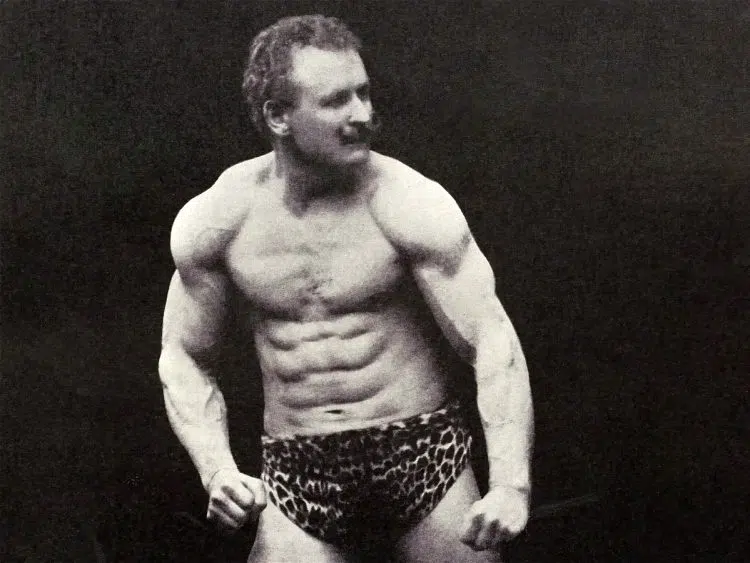I have always been fascinated with strongmen of the 19th century, like Arthur Saxon, who could lift a 300-pound barbell with one hand, and Eugen San.0dow, “The Father of Modern Bodybuilding.”
Strongman competitions are the OG strength sport. In the early years, men established their dominance in their tribes and clans by lifting heavy implements such as rocks and logs.
While these historic strongmen didn’t necessarily have the most aesthetically appealing physiques, they were as strong as oxen.
As a seasoned personal trainer who has been strength training for over 17 years, I grew bored of the vanilla modern fitness programs. Looking for a change, I started researching the diet and training routines of strongmen of the 1920s.
Once I had the basic structure down, I decided to adopt this 1920s strongman diet and training routine as a 30-day challenge. In this article, I share the ins and outs of this experience, including my results and whether you should try this program for yourself.
Researching the Past: Re-Creating a 1920s Fitness Routine

In an age of information overload, endless fitness fads, and Instagram fitness influencers setting new standards, I dove headfirst into the world of these bygone behemoths to discover a timeless blueprint for building strength, improving health, and forging a body that could rival the legends of the past.
Level Up Your Fitness: Join our 💪 strong community in Fitness Volt Newsletter. Get daily inspiration, expert-backed workouts, nutrition tips, the latest in strength sports, and the support you need to reach your goals. Subscribe for free!
I spent over 50 hours poring over vintage training manuals, studying grainy photographs and yellowed newspaper clippings. The first evident piece of the puzzle was that training back then was less about isolating a particular muscle group and more about functional, full-body training.
As you might have guessed, the 1920s strongman diet wasn’t about fancy supplements or meticulously tracked macros. The athletes back then relied mainly on simple, whole foods to support their training and recovery.
Since muscle mass is related to overall strength, muscle growth was incredibly important for these athletes (1). Protein from animal sources like milk, chicken, eggs, steak, and fish was a go-to for these folks.
Sample 1920s Daily Meal Plan For Strongman Athletes
Here is what a normal day of eating for the giants of the 1920s looked like:
- Breakfast: Steak and eggs, oatmeal with fruit and nuts, milk
- Lunch: Roasted chicken or fish, brown rice or potatoes, hearty vegetable soup
- Dinner: Beef stew or lamb chops, baked sweet potato, mixed greens salad
- Snacks: Hard-boiled eggs, fruit, nuts, yogurt
1920s Strongman Exercises
It goes without saying that no two elite strongmen trained the same way, and there was virtually no scientific literature to prove that a certain methodology could produce better results.
However, these athletes primarily relied on compound lifts and bodyweight exercises to build strength. Here is a small list of some of the most popular lifts of that era:
Compound Exercises
These are multi-joint movements that involve multiple muscle groups simultaneously and get you the best bang for the buck.
- Squats: It is regarded as the ultimate leg builder as it targets the glutes, quads, and hamstrings.
- Deadlifts: This exercise tests total body strength, especially targeting the posterior chain.
- Overhead Presses: The test of raw upper body strength. It biases the shoulders.
- Rows: Helps build a thick and strong back and improves posture and overall physique aesthetics.
Bodyweight Exercises
The 1920s strongman athletes employed bodyweight movements to build strength, endurance, and overall athleticism.
- Pull-Ups: Builds upper body pulling strength and a V-taper.
- Dips: Strengthens the triceps, chest, and shoulders.
- Push-Ups: A staple exercise to boost overall upper body strength.
Strongman-Specific Training
You’d be mistaken if you thought strongman athletes of that era hadn’t devised their own exercises. Here are some of the most popular strongman specialized exercises:
- Farmer’s Walk: Builds grip strength and overall endurance.
- Tire Flips: Even before we had rubber tires, strongmen were flipping tires made of stones and iron.
- Stone Lifting: A test of brute power and grip strength. It is one of the main events in today’s strongman competitions.
A 1920s Strongman-Inspired Training Program
A week’s worth of strongman training in that era might look something like this:
- Monday: Compound lifts (squats, deadlifts, presses, rows)
- Tuesday: Bodyweight exercises (calisthenics)
- Wednesday: Rest or active recovery (light cardio or mobility work)
- Thursday: Compound lifts
- Friday: Strongman-specific training (or additional bodyweight work)
- Saturday & Sunday: Rest or active recovery
This is also what I followed for my 30-day challenge. Here is the complete programming for the same:
Monday: Compound Lifts
| Exercise | Sets | Reps | Rest |
| Back Squat | 5 | 5-8 | 3-4 min |
| Deadlift | 3 | 3-5 | 4-5 min |
| Overhead Press | 5 | 5-8 | 2-3 min |
| Barbell Bent-Over Row | 5 | 5-8 | 2-3 min |
| Farmer’s Carry | 3 | 40-60m | As needed |
Tuesday: Bodyweight and Core
| Exercise | Sets | Reps | Rest |
| Pull-ups | 5 | To failure | 2-3 min |
| Dips | 5 | To failure | 2-3 min |
| Handstand Push-ups | 3 | To failure | 3-4 min |
| Hanging Leg Raises | 3 | 15-20 | 1-2 min |
| Plank | 3 | 30-60 seconds | 1-2 min |
Wednesday: Active Recovery
- Light cardio (brisk walk, swim, bike): 30 minutes
- Stretching and mobility work: 15 minutes
Thursday: Compound Lifts (Repeat Monday’s Workout)
Friday: Strongman-Specific Training
| Exercise | Sets | Reps/Distance | Rest |
| Tire Flips | 3 | 5-8 | 3-4 min |
| Sandbag Carry | 3 | 40-60m | As needed |
| Log Press (if equipment available) | 5 | 5-8 | 2-3 min |
| Atlas Stone Lifting (if equipment available) | 3 | 3-5 | 4-5 min |
Saturday & Sunday: Rest or Active Recovery
Remember, you must adjust the programming based on your experience level and training objectives. Beginners should use lighter weights and perform a fewer number of reps and sets.
Gradually increase the weight as you gain more experience and are more comfortable with the movements.
Also, always perform a thorough warm-up before each workout to prime your muscles and reduce injury risk. A cool-down session post-training can help flush toxins and metabolites out of the muscles, improve flexibility, and kickstart the recovery process.
My Detailed Review Of The 30-Day 1920s Strongman Training and Diet Challenge
Here is a summary of my experience:
Level Up Your Fitness: Join our 💪 strong community in Fitness Volt Newsletter. Get daily inspiration, expert-backed workouts, nutrition tips, the latest in strength sports, and the support you need to reach your goals. Subscribe for free!
Embracing the Experiment: Week One
Make no mistake — this isn’t your average hypertrophy-focused training program. The sheer volume of the first training session, which comprised a total of 21 sets, gave me some serious delayed-onset muscle soreness (DOMS) on the next day.
That’s not it; eating like a strongman was no easy task either. Five meals a day with a whole lot of protein and healthy fats keeps you feeling full for long periods.
The first week was a humbling experience. I had to lower the training volume (sets, reps, and weights) to ensure I was using the correct technique. However, the increased workload significantly improved my sleep, and I dozed off as soon as my head hit the pillow.
Gaining Momentum: Weeks Two and Three
I noticed a serious improvement in my strength in the second week. The weights I struggled with in Week One were now feeling manageable, signaling an increased work capacity.
I focused on gradually increasing the volume in each exercise to push my physical and mental limits. Remember, strongman training is as psychological as it is physical. Pushing ungodly weights requires discipline and mental resilience.
My digestion improved drastically in the third week as my stomach got used to the high amount of food. I felt less bloated and lighter overall and had more energy throughout the day.
The Final Push: Week Four and Beyond
I entered the final week with a ‘pead to the metal’ mindset, ensuring I didn’t leave anything in the tank.
I added variations of the functional exercises mentioned above in my training program to break the monotony and challenge myself further. This worked as I was leaner and denser compared to how I had started the program.
I didn’t know what to expect when I started this 30-day 1920s strongman diet and training challenge, but I’m glad I took the leap.
While I might not stick to the exact training regime mentioned in this article forever, I will adopt many of the strongman training principles and apply them to my regular hypertrophy-focused training to improve my overall functionality and performance.
The Modern vs. Vintage Showdown: Lessons Learned
A month of living like a 1920s strongman has been an eye-opener, revealing stark contrasts between then and now. Given below is a comparison of the old-school methods and the modern ways:
| Feature | 1920s | The Modern Era |
| Diet | Whole, unprocessed foods | Precise macro tracking, personalized diet plans |
| Training | Functional, bodyweight-focused exercises | State-of-the-art gyms, cutting-edge techniques |
| Lifestyle | Rest and recovery prioritized | Constant stress, sleep deprivation |
Results of the 1920s Strongman Challenge
Below is a detailed report of the results I achieved through this training program:
| Parameter | Before | After |
| Body Weight (lbs) | 180 | 185 |
| Chest Circumference (in) | 40 | 42 |
| Waist Circumference (in) | 34 | 33 |
| Shoulder Circumference (in) | 48 | 50 |
| Arm Circumference (in) | 14 | 15 |
| Thigh Circumference (in) | 22 | 24 |
| One-Rep Max Deadlift (pounds) | 350 | 405 |
| One-Rep Max Bench Press (pounds) | 225 | 275 |
| One-Rep Max Squat (pounds) | 300 | 365 |
| Body Fat Percentage (%) | 17 | 16.5 |
I couldn’t have asked for better results from this 30-day challenge. I saw improvement in almost every department. Let’s break it down:
Strength Gains
From the second week, I felt an increase in my raw power, translating to new PBs. I achieved bigger numbers on all major lifts, including the deadlift, bench press, and squat. The exact details of these lifts can be seen in the table above.
Body Composition Changes
Although I was not expecting it, I witnessed an improvement in my overall lean muscle mass. My body fat dropped, revealing definition, greater muscle density, and separation.
This proves that a calorie surplus doesn’t always result in fat accumulation, especially if you’re combining it with an increased physical output.
Overall Health Markers
Typically, eating more food makes me lethargic. However, this was not the case on this 30-day challenge. This old-school high-protein diet had plenty of complex carbs to fuel my workouts and daily activity.
Another unexpected benefit of this program was a deeper sleep and waking up feeling refreshed.
Conclusion
Strongmen of the 1920s trained with raw iron, ate real food, and embraced a holistic approach to fitness that extended beyond mere muscle mass.
So, will I ditch the modern health and fitness protocols and settle for what I learned from the 20th-century legends? Well, not really. In my opinion, the most effective training and diet approach should be a balance of the two. It should focus on the basics while incorporating the most cutting-edge research available to maximize the results.
If you have any questions about the 1920s strongman diet and training routine mentioned in this article, drop them in the comments below, and I’ll be happy to help!
References
- Riviati N, Indra B. Relationship between muscle mass and muscle strength with physical performance in older adults: A systematic review. SAGE Open Med. 2023;11:20503121231214650. Published 2023 Nov 27. doi:10.1177/20503121231214650










